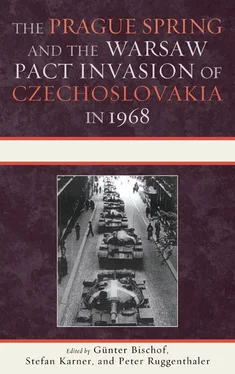This last statement was by no means coincidental. Within the Soviet leadership not the least doubts surfaced as to the justification and the timing of the “military-political operation” either in the summer of 1968 or in later years. The differences of opinion that did exist did not concern questions of principle, but mainly such issues as the pacing and the methods of “regulation” of the Czechoslovak crisis between August 1968 and April 1969, a phase in which Dubček and his comrades-in-arms attempted to keep some elements of their former political line alive. This conviction of the Soviet leaders cannot be explained in terms of their conservative mind-sets or their open fear of an impending collapse of the Soviet camp. A significant role in this concrete case must be assigned to the factors of the Cold War and the bipolar world order. The Brezhnev Doctrine as well as the Sonnenfeld Doctrine, which both concern the definition of the spheres of influence of the two superpowers and which were not frequently cited officially but often applied in practice were most strongly in evidence during the Czechoslovak crisis in the summer of 1968.
The knowledge and analysis of the declassified documents relating to the ČSSR crisis in the context of the time enables us to correct several theses, which have been formulated in recent years regarding the Czechoslovak crisis, including in particular claims to the effect that events in Czechoslovakia are said to have established the impossibility, in principle, of reforming the Socialist system. 117This also applies to the thesis which sees Dubček as not only engaged in building some kind of a “Utopian society,” but also as someone who was a notoriously more orthodox Marxist in the Socialist sense of the nineteenth century than the Soviet leaders themselves. 118It is quite obvious that both postulates are in need of a certain amount of refinement.
As far as the impossibility of reforming the Socialist system is concerned—it is a fact that all attempted reforms either ushered in Soviet tanks or a complete switch to a capitalist system—one must not lose sight of the fact that this concerned a Soviet variant of the Socialist system of which, to use a contemporary metaphor from genetics, a cloned copy was installed in most Eastern European countries involving the use of force. Even Vladimir Lenin admitted repeatedly that there was a huge difference between the proletarian revolution of Marxist theory and what had emerged as a result of the Russian Revolution. All subsequent statements which claimed that the road chosen by the USSR was the one and only model to be followed, as well as the fact that the “progressive” Soviet experiences were forced on the other countries, were the sole responsibility of the Soviet party functionaries and ideologues. The result was the inevitable isolation of the Soviet model of communism in most “people’s democracies”—in our concrete case, in Czechoslovakia. This, in turn, led to the impossibility of reforming the inadequacies of this model.
Painting Dubček in the role as the last of the Marxist-Leninists is hardly borne out by the facts. In order to get to the top in a Communist Party of the Leninist-Stalinist persuasion, which the KSČ was beyond a shadow of a doubt, one had to have character attributes and capabilities that are entirely incompatible with the “heroic figure” of a fighter against Soviet totalitarianism. If there is talk of struggles within the KSČ leadership, it must not be overlooked that even those who passed in the Soviet Union for “rightists” were as much representatives of the party nomenclature as their “leftist” or “conservative” opponents. Many of their activities would inevitably conform with those rules of the game that had originally been defined by the circles of the party apparatchiks. Even if they came up with nice mottos featuring “democratic socialism” or “socialism with a human face,” they themselves had hardly a clue how socialism was to be humanized in practice without running afoul of a communism that was prepared to resort to the use of violence.
This is why the positive action program of the Czechoslovak reformers was confined in a number of ways to mere words and promises that defied realization in practice. Their sole use was to fan in the population negative emotions directed against those that “hindered” Czechoslovakia in the process of becoming really free and independent—that is, against the USSR, the CPSU, the orthodox faction within the KSČ, and the Slovak nationalists. These external factors, the hotbed from which sprang newspaper headlines, rallies, and demonstrations, worried the Soviet leadership much more and prompted them much more strongly to take aggressive action than the contradictory processes unfolding subliminally inside the Czechoslovak society. Without even a hint of absolving the USSR and the other four countries that became guilty of crass interference in the internal affairs of a sovereign state from their responsibility, one can assume with an increasing degree of certainty that it was also the shortsighted and ill-considered acts of the Czechoslovak reformers, that is, of those in the party elite of the KSČ on the extreme “right,” that contributed to the absolutely inadequate, if at the time seemingly inevitable, form that the reaction of the USSR and of the other member countries of the Warsaw Pact culminated in: military invasion.
Translated from German into English by Otmar Binder, Vienna.
1. It is owing to this development that over the last few years a large number of documents have been published and many studies have been written which either address the history of the Czechoslovak crisis directly or treat the topic within another context. For details, see Mark Kramer, “The Prague Spring and the Soviet Invasion of Czechoslovakia: New Interpretations, Part 1,” CWIHP Bulletin 2 (1992): 1, 4–13, and “The Prague Spring and the Soviet Invasion of Czechoslovakia: New Interpretations, Part 2,” CWIHP Bulletin 3 (1993): 2–13, 54–55. See also R. G. Pikhoya, “Chechoslovakiya, 1968 god,” Novaya i novejshaya istoriya 6 (1994), 1 (1995); Lutz Priess et al., eds., Die SED und der “Prager Frühling” 1968: Politik gegen einen “Sozialismus mit menschlichem Antlitz” (Berlin: Akademie Verlag, 1996); Mikhail Latysh, “Prazhskaya vesna” 1968 g. i reaktsija Kremlya (Moscow: Moskva, 1998); R. G. Pikhoya, Sovetskii Soyuz: Istoriya vlasti, 1945–1991 (Moscow and Novosibirsk: Sibirskii Khronograf, 1998); Jaromir Navrátil et al., eds., The Prague Spring 1968: A National Security Archive Documents Reader (Budapest: Central European University Press, 1998); Mark Kramer, ed., “Ukraine and the Soviet-Czechoslovak Crisis of 1968, Part 1, New Evidence from the Diary of Petro Shelest,” CWIHP Bulletin 10 (1998); Jeremi Suri, Power and Protest: Global Revolution and the Rise of Détente (Cambridge, MA: Harvard University Press, 2003); Frank Umbach, Das rote Bündnis: Entwicklung und Zerfall des Warsaw Pact, 1955 bis 1991 (Berlin: Ch. Links, 2005); Vladislav M. Zubok, A Failed Empire: The Soviet Union in the Cold War from Stalin to Gorbachev (Chapel Hill: University of North Carolina Press, 2007).
2. RGANI, F. 3, op. 72, d. 145, pp. 7–8, 12, Politburo resolution of the CC CPSU, “Questions Concerning Czechoslovakia,” 25 January 1968; RGANI, F. 3, op. 72, d. 146, pp. 4, 29–30, Politburo resolution of the CC CPSU, “On Functions in Connection with Dubček Visiting the USSR,” 29 January 1968; RGANI, F. 3, op. 72, d. 151, pp. 2–12, Politburo resolution of the CC CPSU, “Questions Concerning GKES, the Gosplan of the USSR and the USSR Defense Ministry.” Attachment: resolution of the Council of Ministers of the USSR, “Über die technische Zusammenarbeit der Tschechoslowakei und Polens in der Organisation von Infanteriemaschinen und über den Ankauf solcher Maschinen für die Sowjetunion in der Tschechoslowakei.” Attachment nos. 1, 2, 3 to the resolution of the Council of Ministers, 21 February 1968.
Читать дальше












